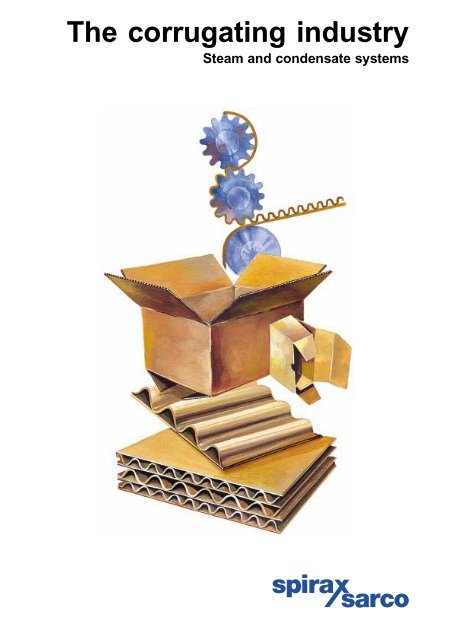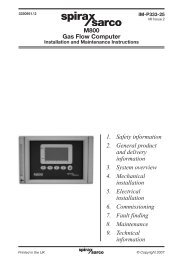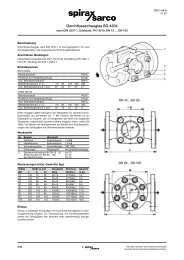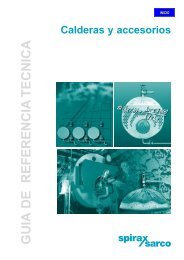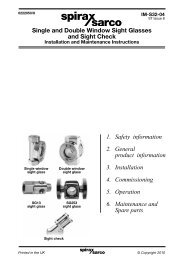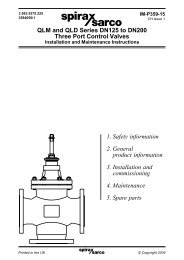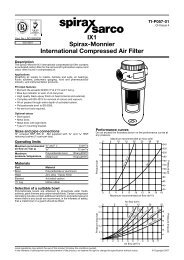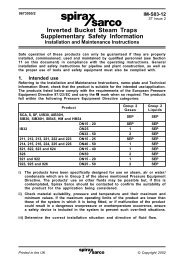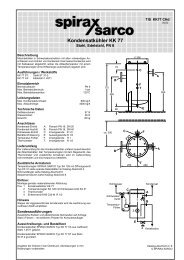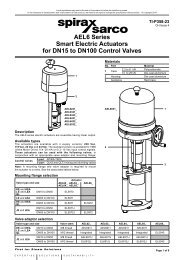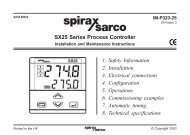The Corrugating Industry Steam and Condensate ... - Spirax Sarco
The Corrugating Industry Steam and Condensate ... - Spirax Sarco
The Corrugating Industry Steam and Condensate ... - Spirax Sarco
You also want an ePaper? Increase the reach of your titles
YUMPU automatically turns print PDFs into web optimized ePapers that Google loves.
<strong>The</strong> corrugating industry<br />
<strong>Steam</strong> <strong>and</strong> condensate systems
<strong>The</strong> well managed use of high quality steam is<br />
a major factor in producing premium quality<br />
board at optimum machine speeds<br />
What is steam used for<br />
Corrugated fibreboard is produced by glueing a liner to<br />
a fluting. <strong>The</strong> fluting, sometimes referred to as the<br />
corrugating medium, is formed by a pair of steam heated<br />
corrugating rolls.<br />
<strong>Steam</strong> is used for conditioning <strong>and</strong> to provide the heat<br />
necessary in the forming <strong>and</strong> bonding processes carried<br />
out by the machine.<br />
<strong>The</strong> need for high quality steam<br />
<strong>Steam</strong> is used because it is an efficient carrier of heat.<br />
To enable temperatures to be controlled accurately it<br />
is essential that high quality dry saturated steam is<br />
delivered to the machine at the correct pressure. Any<br />
entrained moisture or incondensable gases in the steam<br />
will lower its temperature <strong>and</strong> impair the heat transfer<br />
rate. This will make accurate control difficult <strong>and</strong> in some<br />
cases it may not even be possible to achieve the desired<br />
production temperatures.<br />
It is produced in the boiler <strong>and</strong> carried to the corrugator<br />
by a pipework distribution system. At the corrugator it<br />
gives up heat to the various processes <strong>and</strong> condenses.<br />
A very important property of saturated steam is that its<br />
temperature is directly related to its pressure. <strong>The</strong>refore<br />
the temperature of the heated cylinders <strong>and</strong> hot plates<br />
on a corrugator can be accurately controlled by<br />
controlling the pressure of the steam.<br />
Temperature °C<br />
250<br />
200<br />
150<br />
100<br />
50<br />
<strong>Steam</strong> saturation<br />
curve<br />
Modern high speed corrugators operate at<br />
temperatures up to 190°C, requiring a steam supply<br />
between 14 <strong>and</strong> 16 bar.<br />
0<br />
0 2 4 6 8 10 12 14 16<br />
Pressure bar g<br />
2
<strong>Spirax</strong> <strong>Sarco</strong><br />
in the corrugating industry<br />
For most of the 20th century <strong>Spirax</strong> <strong>Sarco</strong> has been the leader<br />
in improving steam plant efficiency, providing knowledge<br />
<strong>and</strong> high quality products to all branches of industry,<br />
including the corrugating industry.<br />
We underst<strong>and</strong> that the corrugating industry<br />
has its particular needs <strong>and</strong> problems, <strong>and</strong> that<br />
each application within the industry should be looked<br />
at individually.<br />
We can provide solutions to problems<br />
around the complete steam <strong>and</strong> condensate system in the<br />
corrugating industry, anywhere in the world.<br />
<strong>Steam</strong><br />
distribution<br />
<strong>Steam</strong><br />
generation<br />
<strong>Steam</strong> control<br />
<strong>and</strong><br />
management<br />
<strong>Condensate</strong><br />
management<br />
To produce high quality board while maintaining low<br />
production costs it is essential that the corrugator runs<br />
at its most efficient speed, <strong>and</strong> efficiently uses the heat<br />
available in the steam.<br />
To achieve this, it is necessary to consider the design<br />
<strong>and</strong> operation of the complete steam <strong>and</strong> condensate<br />
system, taking into account the type of corrugator, its<br />
speed, the local environment <strong>and</strong> the different types of<br />
board being produced.<br />
<strong>The</strong> complete system<br />
Consideration should also be given to future expansion<br />
plans <strong>and</strong> plans to upgrade existing machines.<br />
New machines are manufactured <strong>and</strong> existing machines<br />
are being upgraded to run at higher speeds, producing<br />
more board per day. Individual corrugators are now<br />
required to be versatile <strong>and</strong> produce many different types<br />
of board, with quick change-over times from one product<br />
to another.<br />
3
<strong>Spirax</strong> <strong>Sarco</strong> <strong>and</strong> steam generation<br />
<strong>Steam</strong> leaving the boiler house should contain as<br />
little moisture <strong>and</strong> incondensable gases as possible.<br />
This will ensure that the maximum amount of heat is<br />
available at the corrugator <strong>and</strong> minimise the risk of<br />
pipeline damage from waterhammer.<br />
<strong>Spirax</strong> <strong>Sarco</strong> has the expertise to help you produce<br />
high quality steam from your boilers, at the most<br />
economical cost, with a wide range of products<br />
specifically designed for the boiler house, all<br />
manufactured to the highest st<strong>and</strong>ards.<br />
We have technical <strong>and</strong> sales literature available on<br />
the subject of boiler house applications <strong>and</strong><br />
equipment available upon request.<br />
An essential part of boiler house design <strong>and</strong><br />
operation is ensuring the boiler operates at the<br />
highest possible efficiency. Every effort should be<br />
made to recover <strong>and</strong> reuse the heat available from<br />
secondary sources such as boiler blowdown.<br />
Your local <strong>Spirax</strong> <strong>Sarco</strong> engineer will be able to help<br />
<strong>and</strong> offer advice on how this can be achieved.<br />
Cold water make-up controls<br />
Boiler feedtanks<br />
Feedtank controls<br />
Deaerator heads<br />
Air vents <strong>and</strong> vacuum breakers<br />
Feedtank recirculation systems<br />
Boiler blowdown heat recovery systems<br />
Vent heads<br />
<strong>Steam</strong> injection systems<br />
Boiler blowdown systems<br />
Blowdown vessels<br />
Blowdown inlet manifolds<br />
Level controls <strong>and</strong> alarm systems<br />
TDS control systems<br />
TDS measurement<br />
Feedpump check valves<br />
Sample coolers<br />
Flash vessels<br />
Residual blowdown heat exchangers<br />
Cooling water systems<br />
<strong>Steam</strong> main start-up systems<br />
<strong>Condensate</strong> contamination detection systems<br />
<strong>Condensate</strong> dump valves<br />
Supplied by <strong>Spirax</strong> <strong>Sarco</strong><br />
boiler feedwater<br />
steam flash steam condensate<br />
<strong>Spirax</strong> <strong>Sarco</strong> boiler house equipment<br />
4
<strong>Spirax</strong> <strong>Sarco</strong> <strong>and</strong> steam distribution<br />
Air<br />
vent<br />
Various outputs<br />
alarms<br />
RS232C Interface<br />
timers<br />
<strong>Steam</strong> flow<br />
<strong>Steam</strong> flow<br />
Separator<br />
Spiraflo<br />
meter<br />
Wafer<br />
check valve<br />
<strong>Steam</strong> trap set<br />
<strong>Condensate</strong> out<br />
<strong>Spirax</strong> <strong>Sarco</strong> steam metering station<br />
Air<br />
vent<br />
<strong>Steam</strong> flow<br />
From the boiler house the steam is carried to the<br />
corrugating machine by the distribution system. It<br />
should be available at the corrugator at the correct<br />
pressure, in sufficient quantity <strong>and</strong> in the best possible<br />
condition.<br />
<strong>Steam</strong> flow<br />
<strong>Steam</strong> trap set<br />
It is important that pipework carrying steam from the<br />
boiler house to the corrugator is sized correctly. <strong>Steam</strong><br />
velocity should be at a reasonable level <strong>and</strong> the<br />
pressure drop kept to a minimum. <strong>Spirax</strong> <strong>Sarco</strong> will be<br />
happy to advise on your distribution pipework sizing.<br />
<strong>The</strong> installation of accurate steam metering equipment<br />
will enable you to monitor corrugator performance,<br />
assist in energy management <strong>and</strong> provide information<br />
that will help in the accurate costing of board production.<br />
This can be particularly important when one corrugator<br />
makes different types of board.<br />
To ensure that radiation losses are kept to a minimum<br />
the steam distribution system should be insulated. Even<br />
when insulated some radiation losses will occur, with<br />
some steam condensing <strong>and</strong> forming condensate in<br />
the pipework.<br />
It is important that this condensate is removed so that<br />
the steam arriving at the corrugator is as dry as<br />
possible. <strong>The</strong> removal of condensate from the<br />
distribution pipework is also necessary to prevent<br />
damage from waterhammer. This occurs when slugs<br />
of condensate are propelled along the pipeline at<br />
steam velocity.<br />
<strong>Spirax</strong> <strong>Sarco</strong> relay point<br />
<strong>Condensate</strong> out<br />
<strong>Condensate</strong> can be removed by means of a separator<br />
as shown in the illustration of a steam metering station,<br />
<strong>and</strong> in the case of long distribution runs, a relay drain<br />
point should be installed. Provision should also be made<br />
for removing air <strong>and</strong> incondensable gases from the<br />
steam distribution system through strategically placed<br />
thermostatic air vents.<br />
<strong>Condensate</strong> forms due to radiation losses from the pipe<br />
If it is not removed, a slug of condensate can develop <strong>and</strong> be<br />
carried along the pipe at steam velocity.<br />
<strong>The</strong> cause of waterhammer<br />
5
<strong>Spirax</strong> <strong>Sarco</strong> <strong>and</strong><br />
<strong>Steam</strong> in<br />
<strong>Steam</strong> in<br />
Rotary<br />
joint<br />
Rotary<br />
joint<br />
Cylinder<br />
Cylinder<br />
Spiraview<br />
sight glass<br />
Blow-through<br />
valve<br />
Float <strong>and</strong> thermostatic steam<br />
trap set<br />
<strong>Spirax</strong> <strong>Sarco</strong> steam trap set for low speed<br />
cylinder<br />
Float <strong>and</strong> thermostatic steam trap set<br />
with blow through connection<br />
<strong>Spirax</strong> <strong>Sarco</strong> steam trap set with provision for<br />
blow-through<br />
Upper<br />
corrugating<br />
cylinder<br />
<strong>Steam</strong> shower<br />
Preheater<br />
Press<br />
roll<br />
First single facer<br />
Pre-conditioner<br />
Preheater<br />
Lower<br />
corrugating<br />
cylinder<br />
Glue<br />
roll<br />
Second single facer<br />
Controller<br />
Air<br />
supply<br />
Pneumatic valve <strong>and</strong> actuator<br />
with positioner<br />
Power<br />
supply<br />
Separator<br />
Pressure sensor<br />
<strong>Steam</strong> trap set<br />
<strong>Spirax</strong> <strong>Sarco</strong> reducing valve station<br />
6
the corrugator<br />
Air<br />
supply<br />
Pneumatic reducing<br />
valve station<br />
Flash steam<br />
from cascade<br />
system<br />
Live steam<br />
Hot plates<br />
<strong>Spirax</strong> <strong>Sarco</strong> hot plate control<br />
<strong>Steam</strong> trap sets<br />
Glue<br />
Machine<br />
Felt<br />
shower<br />
Hot plates<br />
Triplex<br />
Preheater<br />
Double backer section<br />
Separator<br />
Signal from<br />
drive control system<br />
Air supply<br />
<strong>Steam</strong> trap set<br />
Actuated<br />
ball valve<br />
<strong>Steam</strong> trap<br />
<strong>Steam</strong> shower<br />
<strong>Spirax</strong> <strong>Sarco</strong> steam shower control<br />
7
<strong>The</strong> steam supply<br />
Corrugators require a primary steam pressure of<br />
between 7 bar for older style machines, up to 16 bar<br />
for the newer high speed machines.<br />
Whatever type of steam or condensate management<br />
system is used, the primary steam pressure onto the<br />
corrugator must be correct <strong>and</strong> stable. <strong>The</strong> corrugating<br />
rolls, small preheaters, press rolls <strong>and</strong> first section of<br />
the double backer usually operate at the highest<br />
temperature. <strong>The</strong>y require high pressure steam within<br />
± 0.3 bar ( ± 2°C ).<br />
Different types of reducing valve are available, from<br />
simple direct acting valves to the more flexible<br />
pneumatic actuator, valve <strong>and</strong> electropneumatic<br />
positioner combinations.<br />
<strong>The</strong> choice of main reducing valve type should depend<br />
on the needs of the corrugator.<br />
Space heating <strong>and</strong> humidification requirements must<br />
be taken into consideration in order to provide the<br />
optimum conditions for board preparation <strong>and</strong> storage.<br />
<strong>Spirax</strong> <strong>Sarco</strong> has extensive experience in this area <strong>and</strong><br />
can provide advice on your heating <strong>and</strong> humidification<br />
systems.<br />
Static heated cylinders<br />
Some corrugators will have static cylinders used as<br />
preheaters. Depending upon the temperature required,<br />
these are provided with steam at pressures ranging<br />
from 3 bar up to 16 bar. Because they are static, steam<br />
inside will condense <strong>and</strong> form a puddle in the bottom.<br />
Normally a syphon pipe will be fitted inside <strong>and</strong> the<br />
pressure differential between the steam inlet <strong>and</strong> the<br />
condensate outlet will allow condensate to flow up the<br />
syphon pipe <strong>and</strong> out of the cylinder.<br />
A corrugator that will always require the same pressure<br />
at the high temperature rolls with a reasonably stable<br />
dem<strong>and</strong> could safely use a correctly sized direct acting<br />
reducing valve.<br />
A corrugator that requires varying pressures at the high<br />
temperature rolls, with the supply pressure adjusted<br />
through a single controller or from a central machine<br />
control panel, would benefit from a pneumatic based<br />
system with its high accuracy <strong>and</strong> remote adjustment<br />
capabilities.<br />
<strong>Spirax</strong> <strong>Sarco</strong> can supply many different types of steam<br />
pressure control system, <strong>and</strong> can advise on the best<br />
choice for your particular application.<br />
Syphon pipe<br />
Static cylinder section<br />
<strong>Condensate</strong> puddle<br />
<strong>Steam</strong> in<br />
<strong>Condensate</strong><br />
out<br />
Where is steam used<br />
On a corrugator steam is used in three main areas:<br />
Rotating <strong>and</strong> static cylinders which heat the fluting<br />
medium, liner <strong>and</strong> finished board, including the<br />
corrugating rolls which form the fluting.<br />
<strong>Steam</strong> sprays which moisten <strong>and</strong> heat the fluting<br />
medium prior to corrugation. <strong>Steam</strong> sprays which<br />
heat, moisten <strong>and</strong> clean the double backer felt.<br />
Hot plates which dry the board <strong>and</strong> set the starch<br />
before the finishing processes.<br />
A typical corrugator producing double walled board<br />
consists of two single facer units with a double backer<br />
section, all using steam at various pressures.<br />
In addition, finishing sections will contain slitters,<br />
scorers, cutters, on-line printers etc. that do not require<br />
steam for their operation, but will require steam for<br />
space heating <strong>and</strong> humidification.<br />
<strong>The</strong> correct choice of steam trap for this application<br />
will be a ball float (FT) type with integral air vent <strong>and</strong><br />
steam lock release valve. This will ensure that<br />
condensate is drained from the roll as soon as it is<br />
formed <strong>and</strong> allow incondensable gases to pass through<br />
the thermostatic air vent, allowing maximum heat<br />
transfer across the cylinder wall.<br />
<strong>The</strong> steam lock release valve will allow any<br />
uncondensed steam in the syphon pipe, which may<br />
cause the steam trap to shut <strong>and</strong> condensate to<br />
back-up, to bleed away.<br />
Rotating heated cylinders<br />
<strong>The</strong> majority of steam heated cylinders on a corrugator<br />
rotate. <strong>Steam</strong> enters the roll <strong>and</strong> condensate exits<br />
through a rotary joint. <strong>The</strong> condensate will normally<br />
exit through a stationary syphon.<br />
8
To maintain the correct cylinder surface temperature,<br />
the steam pressure should be accurately controlled <strong>and</strong><br />
the condensate removed as soon as it forms.<br />
<strong>The</strong> way that condensate behaves in a rotating cylinder<br />
is influenced by many factors, including cylinder<br />
diameter, machine speed, condensation rate <strong>and</strong> the<br />
depth of the condensate rim inside the cylinder.<br />
Depending upon these various factors it can be either<br />
'puddling', 'cascading' or 'rimming'.<br />
Puddling<br />
Stationary condition<br />
On low speed rolls, where rimming does not occur, a<br />
ball float (FT) steam trap fitted with a thermostatic air<br />
vent <strong>and</strong> steam lock release valve, to prevent steam<br />
locking, should be suitable. Other types of steam trap<br />
may also be suitable depending upon the operating<br />
conditions.<br />
Where it is known that rimming will occur it may be<br />
necessary to provide a steam trap / blow-though<br />
combination or even a total blow-through system<br />
without a steam trap.<br />
Rimming is caused when a centrifugal force of<br />
approximately 3 g or more acts upon the condensate<br />
inside a revolving cylinder <strong>and</strong> holds it against the inner<br />
rim. To exit, the condensate must overcome the<br />
centrifugal force, travel up the syphon <strong>and</strong> out through<br />
the rotary joint.<br />
In most cases the use of stationary syphons <strong>and</strong> the<br />
high differential pressures across the cylinders on a<br />
corrugator will be enough to overcome this force. When<br />
this is not the case, blow-through steam may need to<br />
be introduced to assist in condensate removal.<br />
Blow-through is steam that enters the roll but does not<br />
condense. It forms a mixture with the condensate that<br />
is less dense <strong>and</strong> travels at higher velocity. A typical<br />
mixture will be 20% blow-through steam by weight.<br />
Cascading<br />
On a corrugator cylinder the percentage of blowthrough<br />
is normally controlled by a simple orifice or<br />
needle valve.<br />
Rotating cylinder<br />
Rimming<br />
It is necessary to know what is happening to the<br />
condensate at actual machine operating speeds to be<br />
able to decide upon the most effective <strong>and</strong> economic<br />
method of condensate removal.<br />
<strong>The</strong> first choice to make will be that of the syphon.<br />
Given the necessary data, specialists in this field will<br />
be able to advise on the correct type <strong>and</strong> size.<br />
Different methods can be used to ensure that<br />
condensate exits <strong>and</strong> drains away from a cylinder. <strong>The</strong>re<br />
is no single universal choice as individual operating<br />
conditions vary from corrugator to corrugator, <strong>and</strong> even<br />
from cylinder to cylinder on an individual corrugator.<br />
Hot plates<br />
Groups of steam heated hot plates provide final<br />
conditioning to the board before the finishing processes.<br />
A number of individual chests are normally grouped<br />
into three sections. Each section will need its own<br />
steam control valve <strong>and</strong> each chest will need its own<br />
steam trap set.<br />
<strong>The</strong> first section normally requires high pressure steam<br />
to provide a high temperature. <strong>The</strong> following sections<br />
will require medium or low pressure steam, through<br />
steam reducing valve sets.<br />
If a cascade type condensate management system<br />
is installed, much of the dem<strong>and</strong> on the medium <strong>and</strong><br />
low pressure hot plates may be met by flash steam<br />
released from the high pressure sections of the<br />
corrugator. A reducing valve set will also be required<br />
to provide make-up steam in case the flash steam<br />
cannot satisfy the whole dem<strong>and</strong>.<br />
9
<strong>Steam</strong> showers<br />
Low pressure steam showers are found in two locations<br />
on a corrugator.<br />
<strong>The</strong> first location is the single facer where steam is<br />
used to moisten <strong>and</strong> heat the corrugating medium prior<br />
to passing through the corrugating rolls.<br />
<strong>The</strong> second location is the double backer where steam<br />
showers heat, moisten <strong>and</strong> clean the felt that presses<br />
the board onto the hot plates.<br />
<strong>The</strong> showers are fed with low pressure steam either<br />
through a pressure reducing valve set, or with flash<br />
steam from the cascade system together with low<br />
pressure steam make-up.<br />
It is important that this steam is dry <strong>and</strong> does not<br />
contain any entrained water droplets that could spray<br />
onto the board <strong>and</strong> mark it or cause it to break.<br />
<strong>The</strong>refore a steam separator should always be fitted<br />
before a steam shower to remove any entrained water<br />
in the steam.<br />
Provision should also be made to shut the steam<br />
supply to the shower when the corrugator stops<br />
running, preventing localised wetting. This can be<br />
accomplished by fitting an actuated ball valve in the<br />
steam supply line to the shower, operated from the<br />
drive control system.<br />
<strong>Spirax</strong> <strong>Sarco</strong> <strong>and</strong> condensate management<br />
Heat recovery<br />
Approximately 30% of the heat used to generate steam<br />
at 14 bar remains in the condensate when the steam<br />
condenses. <strong>The</strong>refore in condensate management,<br />
consideration should be given to recovering <strong>and</strong> using<br />
as much of this heat as possible.<br />
Another possible source of wasted heat is the blowthrough<br />
steam introduced to assist in condensate<br />
removal from rotating cylinders. If this steam is not<br />
recovered <strong>and</strong> usefully used, the overall efficiency of<br />
the corrugator will be lowered.<br />
Flash steam<br />
Flash steam will be released from condensate if its<br />
pressure decreases. Low pressure condensate has a<br />
smaller sensible heat content than high pressure<br />
condensate, <strong>and</strong> this sudden excess heat content will<br />
cause some of the condensate to 'flash off' into steam<br />
at the lower pressure.<br />
Cascade systems<br />
One method used to recover <strong>and</strong> use flash <strong>and</strong><br />
blow-through steam is a cascade type condensate<br />
management system.<br />
A corrugating machine requires steam at various<br />
pressures, <strong>and</strong> the release of flash steam from high<br />
pressure condensate can be controlled to satisfy part<br />
of this steam dem<strong>and</strong>.<br />
High<br />
pressure<br />
steam<br />
Pressure reduction<br />
HP to MP<br />
Pressure reduction<br />
MP to LP<br />
HP = High pressure<br />
MP = Medium pressure<br />
LP = Low pressure<br />
HP<br />
steam<br />
users<br />
MP<br />
flash steam<br />
MP<br />
steam<br />
users<br />
LP<br />
flash steam<br />
LP<br />
steam<br />
users<br />
<strong>Condensate</strong><br />
from HP<br />
steam<br />
<strong>Condensate</strong><br />
from MP<br />
steam<br />
<strong>Condensate</strong><br />
from LP steam<br />
Flash<br />
separator<br />
vessel<br />
Flash<br />
separator<br />
vessel<br />
<strong>Condensate</strong> return unit<br />
<strong>Condensate</strong> to<br />
boiler house<br />
10
Medium pressure flash steam out<br />
Flash separation vessel<br />
Level controller<br />
<strong>Condensate</strong><br />
from high<br />
pressure steam<br />
<strong>Spirax</strong> <strong>Sarco</strong> flash separation<br />
vessel <strong>and</strong> level control system<br />
Level<br />
control<br />
probe<br />
Pump<br />
sets<br />
Motorised<br />
control<br />
valve<br />
<strong>Condensate</strong> out<br />
Flash steam separation<br />
Key components in a cascade system are the flash<br />
separation vessels, where flash <strong>and</strong> blow-through steam<br />
are separated from the condensate.<br />
It is important that condensate is effectively drained<br />
<strong>and</strong> not allowed to build-up in the separators. <strong>The</strong>y can<br />
be drained either by a steam trap, an electrically driven<br />
pump / level control arrangement or a combined steam<br />
trap / pressure powered pump system.<br />
<strong>The</strong> most suitable arrangement will depend on the<br />
needs of the individual corrugator.<br />
For condensate to be removed from any process,<br />
there needs to be a pressure drop between the steam<br />
inlet <strong>and</strong> the condensate outlet. On a corrugator, a<br />
surplussing valve or pressure differential control valve<br />
is often fitted to flash separators to ensure that this<br />
pressure drop is maintained.<br />
<strong>Condensate</strong> return<br />
<strong>The</strong> final stage in condensate management is<br />
returning the hot condensate to the boiler house.<br />
Methods of returning the condensate include simple<br />
gravity return to a vented boiler feedtank <strong>and</strong> high<br />
pressure pumped return directly into the boiler.<br />
Your local <strong>Spirax</strong> <strong>Sarco</strong> engineer will be pleased to<br />
advise on the most cost effective means of achieving<br />
a highly efficient condensate return system.<br />
Medium pressure<br />
flash steam out<br />
<strong>Condensate</strong><br />
from high<br />
pressure steam<br />
Balance line<br />
Air<br />
vent<br />
Motive steam supply<br />
Flash separation vessel<br />
<strong>Steam</strong> trap set<br />
<strong>Condensate</strong> out<br />
Pressure powered pump / trap combination<br />
<strong>Spirax</strong> <strong>Sarco</strong> flash separation vessel <strong>and</strong> self-acting pump / trap<br />
11
A partnership with <strong>Spirax</strong> <strong>Sarco</strong><br />
provides knowledge, service <strong>and</strong> products<br />
worldwide for the control <strong>and</strong> efficient use of<br />
steam <strong>and</strong> other industrial fluids.<br />
l Worldwide support from a team of 3 900 dedicated<br />
employees.<br />
l Local access to <strong>Spirax</strong> <strong>Sarco</strong>'s expertise <strong>and</strong> products<br />
through 39 group companies in 32 countries.<br />
l Valuable information, advice <strong>and</strong> interchange of ideas<br />
from customer training courses held in any of our<br />
31 training centres worldwide.<br />
l A comprehensive range of the highest quality products.<br />
<strong>Spirax</strong> <strong>Sarco</strong> worldwide service<br />
Europe<br />
Austria Vienna<br />
Belgium Zwijnaarde<br />
Czech Republic Prague<br />
Denmark Copenhagen<br />
Finl<strong>and</strong> Helsinki<br />
France Trappes<br />
Germany Konstanz<br />
Hungary Budapest<br />
Irel<strong>and</strong> Dublin<br />
Italy Milan<br />
Netherl<strong>and</strong>s Maarn<br />
Norway Oslo<br />
Pol<strong>and</strong> Warsaw<br />
Portugal Lisbon<br />
Russia St. Petersburg<br />
Spain Barcelona<br />
Sweden Stockholm<br />
Switzerl<strong>and</strong> Zürich - Zollikon<br />
United Kingdom Cheltenham<br />
Africa<br />
Kenya Nairobi<br />
Nigeria Lagos<br />
South Africa Johannesburg<br />
Americas<br />
Argentina Buenos Aires<br />
Brazil São Paulo<br />
Canada Toronto<br />
Mexico Monterrey<br />
USA Columbia S.C.<br />
Asia & Middle East<br />
China Shanghai<br />
Hong Kong<br />
lndia Poona<br />
Indonesia Jakarta<br />
Japan Tokyo<br />
Korea Seoul<br />
U.A.E. Dubai<br />
Malaysia Kuala Lumpur<br />
Pakistan Karachi<br />
Philippines Manila<br />
Singapore<br />
Taiwan Taipei<br />
Thail<strong>and</strong> Bangkok<br />
Australasia<br />
Australia Sydney<br />
New Zeal<strong>and</strong> Auckl<strong>and</strong><br />
Our comprehensive<br />
product range<br />
includes:<br />
l Boiler controls<br />
l Flowmeters<br />
l Pneumatically <strong>and</strong><br />
electronically actuated<br />
control valves<br />
l Pressure reducing valves<br />
l Self-acting temperature<br />
control valves<br />
l Programmable electronic<br />
controllers<br />
l Pneumatic transmitter<br />
controllers<br />
l Safety valves<br />
l <strong>Steam</strong> traps<br />
l <strong>Steam</strong> trap monitoring<br />
systems<br />
l <strong>Condensate</strong> pumps<br />
l Flash vessels<br />
l Separators<br />
l Strainers<br />
l Stop valves<br />
l Check valves<br />
l Humidifiers<br />
A further 46 agencies operate throughout the world.<br />
If you have difficulty finding a local contact please contact us at the number shown below.<br />
CORRUG<br />
<strong>Spirax</strong>-<strong>Sarco</strong> Limited, Charlton House,<br />
Cheltenham, Gloucestershire, GL53 8ER UK.<br />
Tel: +44 (0)1242 521361 Fax: +44 (0)1242 573342<br />
E-mail: Enquiries@<strong>Spirax</strong><strong>Sarco</strong>.com<br />
Internet: www.<strong>Spirax</strong><strong>Sarco</strong>.com<br />
© Copyright 2001 <strong>Spirax</strong> <strong>Sarco</strong> is a registered trademark of <strong>Spirax</strong>-<strong>Sarco</strong> Limited<br />
12<br />
SB-GCM-03 CM Issue 3


